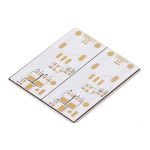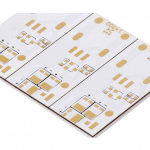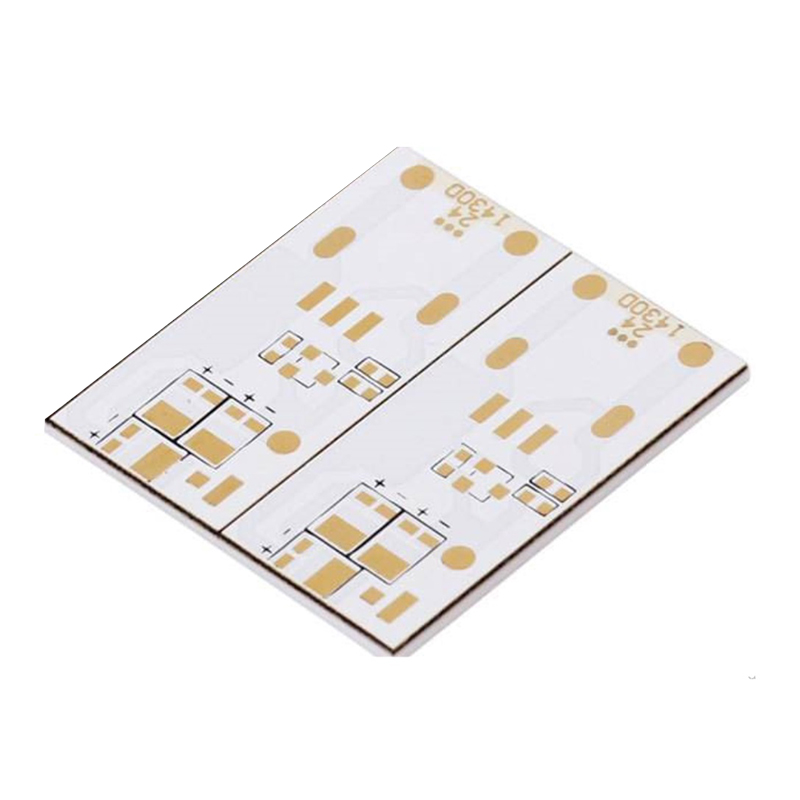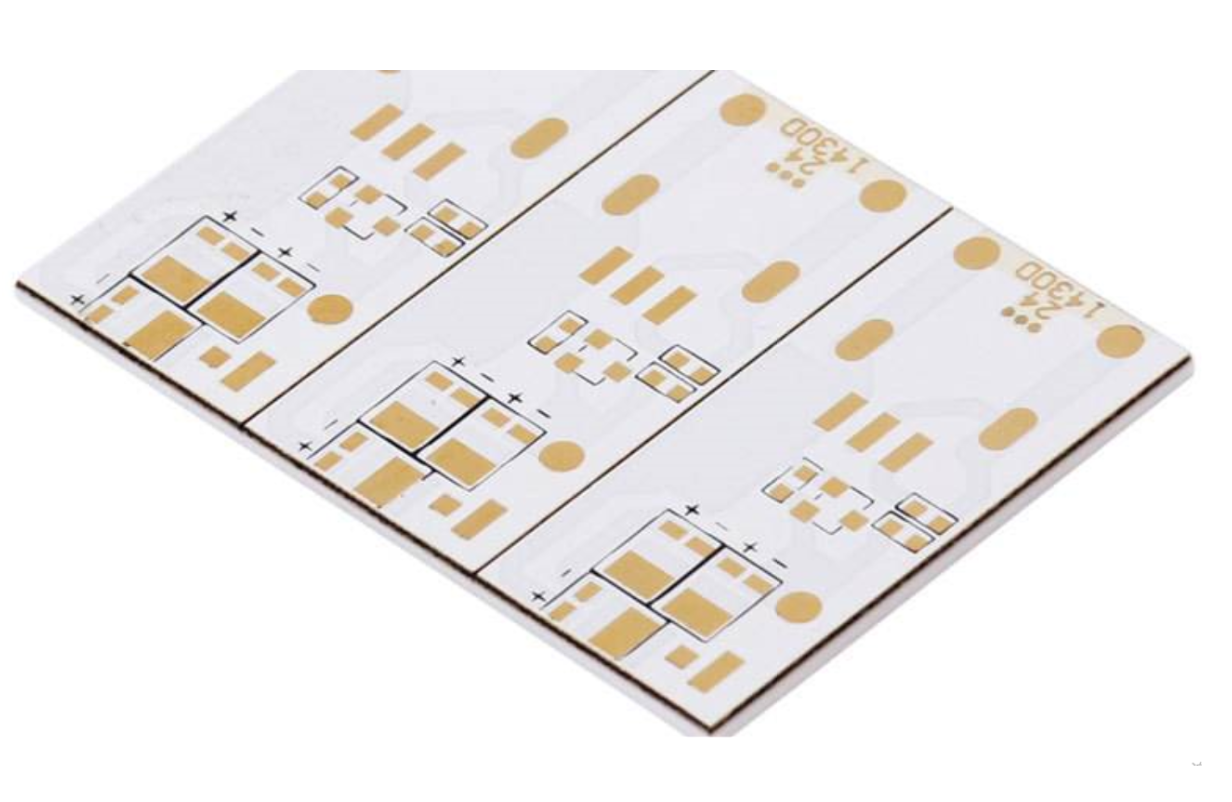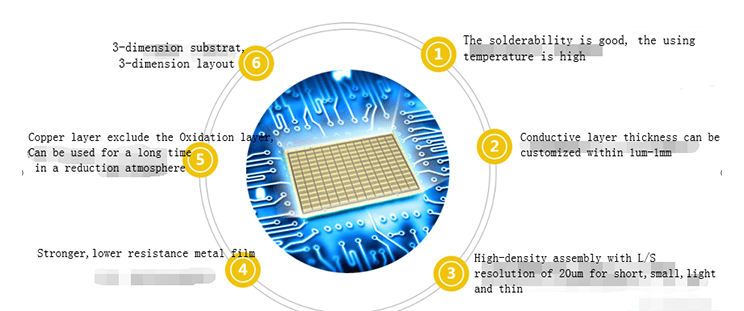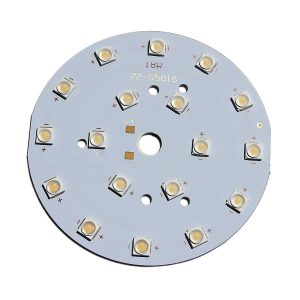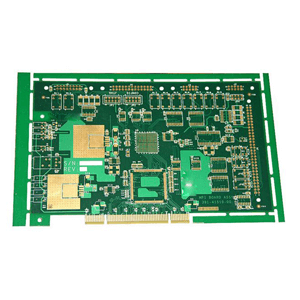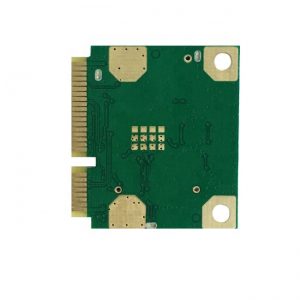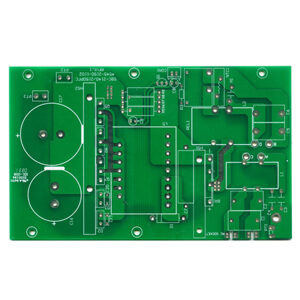Keramikplatinen bestehen tatsächlich aus elektronischen Keramikmaterialien und können in verschiedenen Formen hergestellt werden. Unter diesen weist die Keramikplatine die Eigenschaften eines hohen Temperaturwiderstands und einer hohen elektrischen Isolierung auf. Es hat die Vorteile einer niedrigen Dielektrizitätskonstante, eines geringen dielektrischen Verlusts, einer hohen Wärmeleitfähigkeit, einer guten chemischen Stabilität und ähnlichen Wärmeausdehnungskoeffizienten von Bauteilen. Keramische Leiterplatten werden mit der Laser-Schnellaktivierungs-Metallisierungstechnologie LAM-Technologie hergestellt. Verwendet in LED-Feldern, Hochleistungshalbleitermodulen, Halbleiterkühlern, elektronischen Heizgeräten, Leistungssteuerkreisen, Leistungshybridschaltungen, intelligenten Leistungselementen, Hochfrequenzschaltnetzteilen, Halbleiterrelais, Automobilelektronik, Kommunikation, Luft- und Raumfahrt sowie militärischen elektronischen Bauteilen.
Im Gegensatz zu herkömmlichem FR-4 (Glasfaser) weisen Keramikmaterialien gute hochfrequente und elektrische Eigenschaften sowie eine hohe Wärmeleitfähigkeit, chemische Stabilität und thermische Stabilität auf. Ideales Verpackungsmaterial zur Erzeugung von integrierten Schaltkreisen und Leistungselektronikmodulen in großem Maßstab.
Hauptvorteile:
1. Höhere Wärmeleitfähigkeit
2.Mehr angepasster Wärmeausdehnungskoeffizient
3. Eine härtere Metallfilm-Keramikplatine mit niedrigerem Widerstand
4. Das Substrat hat eine gute Lötbarkeit und hohe Temperatur.
5, gute Isolierung
6. Niedriger Frequenzverlust
7. Bei hoher Dichte zusammenbauen
8. Enthält keine organischen Inhaltsstoffe, beständig gegen kosmische Strahlung, hohe Zuverlässigkeit in der Luft- und Raumfahrt und lange Lebensdauer
9. Die Kupferschicht enthält keine Oxidschicht und kann lange Zeit in einer reduzierenden Atmosphäre verwendet werden.
Technische Vorteile
Einführung in die Keramik-Leiterplattentechnologie zur Herstellung von Prozesslochern
Mit der Entwicklung elektronischer Hochleistungsprodukte in Richtung Miniaturisierung und Hochgeschwindigkeit sind herkömmliches FR-4, Aluminiumsubstrat und andere Substratmaterialien nicht mehr für die Hochleistungs- und Hochleistungsentwicklung geeignet. Mit dem Fortschritt von Wissenschaft und Technologie die intelligente Anwendung der Leiterplattenindustrie. Traditionelle LTCC- und DBC-Technologien werden schrittweise durch DPC- und LAM-Technologien ersetzt. Die durch die LAM-Technologie dargestellte Lasertechnologie entspricht eher der Entwicklung einer Verbindung mit hoher Dichte und der Feinheit von Leiterplatten. Das Laserbohren ist eine Front-End- und Mainstream-Bohrtechnologie für die Leiterplattenindustrie. Die Technologie ist effizient, schnell, genau und hat einen hohen Anwendungswert. RayMingceramic-Leiterplatten werden mithilfe der Laser-Schnellaktivierungs-Metallisierungstechnologie hergestellt. Die Haftfestigkeit zwischen der Metallschicht und der Keramik ist hoch, die elektrischen Eigenschaften sind gut und das Schweißen kann wiederholt werden. Die Dicke der Metallschicht kann im Bereich von 1 um bis 1 mm eingestellt werden, wodurch eine L / S-Auflösung erreicht werden kann. 20 μm können direkt angeschlossen werden, um Kunden maßgeschneiderte Lösungen anzubieten.
Die Keramikplatine hat einen Laserbohrprozess. Die Bindungskraft zwischen der Keramik und dem Metall ist hoch, ohne abzufallen, zu schäumen usw., und der Effekt des Zusammenwachsens, hohe Oberflächenebenheit, Rauheitsverhältnis von 0,1 Mikron bis 0,3 Mikron, Laserschlaglochdurchmesser von 0,15 mm bis 0,5 mm oder sogar 0,06 mm.
Herstellung und Ätzen von Keramikplatinen
Auf der Kupferfolie, die auf der äußeren Schicht der Leiterplatte verbleibt, d. H. Das Schaltungsmuster wird mit einer Schicht aus Blei-Zinn-Resist vorplattiert, und dann wird der ungeschützte nichtleitende Teil des Kupfers chemisch geätzt, um a zu bilden Schaltkreis.
Nach verschiedenen Verfahren wird das Ätzen in Innenschichtätzen und Außenschichtätzen unterteilt. Das Ätzen der inneren Schicht ist Säureätzen, und der nasse oder trockene Film wird als Resist verwendet; Das Ätzen der äußeren Schicht ist alkalisches Ätzen, und Zinn-Blei wird als Resist verwendet. Agent.
Grundprinzipien der Ätzreaktion
1. Ansäuerung von saurem Kupferchlorid
Was ist der Zweck von Keramik für Leiterplatten
Säure-Kupferchlorid-Alkalisierung
Entwicklung: Der Teil des Trockenfilms, der nicht mit ultravioletten Strahlen bestrahlt wurde, wurde durch schwach basisches Natriumcarbonat gelöst und der bestrahlte Teil blieb erhalten.
Ätzen: Entsprechend einem bestimmten Anteil der Lösung wird die durch Auflösen des trockenen oder nassen Films freigelegte Kupferoberfläche durch die saure Kupferchlorid-Ätzlösung aufgelöst und geätzt.
Verblassener Film: Der Schutzfilm auf der Produktionslinie löst sich bei einer bestimmten Temperatur und Geschwindigkeit auf.
Der saure Kupferchloridkatalysator weist die Eigenschaften einer einfachen Steuerung der Ätzgeschwindigkeit, einer hohen Kupferätzleistung, einer guten Qualität und einer einfachen Rückgewinnung der Ätzlösung auf
2. Alkalisches Ätzen
Was ist der Zweck von Keramik für Leiterplatten
Alkalisches Ätzen
Verblassener Film: Entfernen Sie den Film mit Baiser von der Filmoberfläche und legen Sie die unverarbeitete Kupferoberfläche frei.
Ätzen: Unnötige Unterlagen ätzen Kupfer mit einem Ätzmittel weg und hinterlassen dickere Drähte. Unter diesen werden Zusatzgeräte verwendet. Promotoren werden verwendet, um Oxidationsreaktionen zu fördern, um die Ausfällung von Kupferionen zu verhindern; Insektenschutzmittel werden verwendet, um die Seitenerosion zu verringern. Inhibitoren werden verwendet, um die Dispersion von Ammoniak und die Kupferfällung zu unterdrücken und die Oxidation von Kupfer zu beschleunigen.
Neue Emulsion: Verwenden Sie Ammoniakwasser ohne Kupferionen, um die Rückstände mit Ammoniumchloridlösung von der Flüssigkeit auf der Platte zu entfernen.
Volles Loch: Dieses Verfahren gilt nur für den Goldimmersionsprozess. Übermäßige Palladiumionen in nicht plattierten Durchgangslöchern werden hauptsächlich entfernt, um zu verhindern, dass Goldionen beim Goldsenkungsprozess sinken.
Zinnentfernung: Die Zinn-Blei-Schicht wird mit einer Salpetersäurelösung entfernt.
Vier Effekte des Ätzens
1.Pool-Effekt
Während des Ätzherstellungsprozesses bildet die Flüssigkeit aufgrund der Schwerkraft einen Wasserfilm auf der Platte, wodurch verhindert wird, dass neue Flüssigkeit die Kupferoberfläche berührt.
Was ist der Zweck von Keramik für Leiterplatten
Pooleffekt
Grabeneffekt
Die Haftung der chemischen Flüssigkeit bewirkt, dass die chemische Flüssigkeit an der Lücke zwischen der Rohrleitung und der Rohrleitung haftet, was in dichten und offenen Bereichen unterschiedliche Ätzmengen verursacht.
Was ist der Zweck von Keramik für Leiterplatten
Grabeneffekt
3. Durch Effekte
Das flüssige Arzneimittel fließt durch das Loch nach unten, was zu einer Erhöhung der Erneuerungsrate des flüssigen Arzneimittels um das Plattenloch während des Ätzprozesses und zu einer Erhöhung des Ätzbetrags führt.
Was ist der Zweck von Keramik für Leiterplatten
Durch Wirkung
4, Düsenschwingeffekt
Die Linie parallel zur Schwenkrichtung der Düse, da die neue medizinische Lösung die medizinische Lösung leicht zwischen den Linien ableiten kann, die flüssige Medizin schnell aktualisiert wird und die Ätzmenge groß ist;
Die Linie senkrecht zur Schwenkrichtung der Düse, da die neue chemische Flüssigkeit das flüssige Arzneimittel nicht leicht zwischen den Leitungen ableiten kann, das flüssige Arzneimittel mit einer langsameren Geschwindigkeit aufgefrischt wird und die Ätzmenge gering ist.
Was ist der Zweck von Keramik für Leiterplatten
Düsenschwingeffekt
Häufige Probleme bei Ätz- und Verbesserungsmethoden
Filme sind endlos
Weil die Sirupkonzentration sehr niedrig ist; die Leitungsgeschwindigkeit ist zu schnell; Probleme wie das Verstopfen der Düse können endlosen Film verursachen. Daher ist es notwendig, die Sirupkonzentration zu überprüfen und die Sirupkonzentration auf einen geeigneten Bereich einzustellen; Passen Sie die Geschwindigkeit und die Parameter rechtzeitig an. und dann die Düse reinigen.
2. Oberflächenoxidation
Da die Sirupkonzentration zu hoch und die Temperatur zu hoch ist, oxidiert die Oberfläche der Platte. Daher ist es notwendig, die Konzentration und Temperatur des Sirups rechtzeitig einzustellen.
3.Thetecopper ist nicht vollständig
Weil die Ätzgeschwindigkeit zu hoch ist; es gibt eine Abweichung in der Zusammensetzung des Sirups; die Kupferoberfläche ist kontaminiert; die Düse ist blockiert; Die Temperatur ist niedrig und das Kupfer ist nicht fertig. Daher ist es notwendig, die Ätzübertragungsgeschwindigkeit einzustellen; Überprüfen Sie die Zusammensetzung des Sirups erneut. Achten Sie auf Kupferverunreinigungen. Reinigen Sie die Düse, um ein Verstopfen zu vermeiden. Stellen Sie die Temperatur ein.
4. Kupfer ist zu hoch
Da die Maschine zu langsam läuft, die Temperatur zu hoch ist usw. kann dies zu übermäßiger Kupferkorrosion führen. Daher sollten Maßnahmen wie das Einstellen der Geschwindigkeit und Temperatur der Maschine getroffen werden.
|
Artikel |
Beschreibung |
Fähigkeit |
|
|
Sercive |
Leiterplatten- und SMT-Baugruppe aus einer Hand |
||
|
Material |
Laminatmaterialien |
FR4, hohe TG FR4, hohe Frequenz, Alaun, FPC |
|
|
Brettschneiden |
Anzahl der Schichten |
1-48 |
|
|
Mindestdicke für innere Schichten (Cu-Dicke sind ausgeschlossen) |
0,07 mm (0,003 Zoll) |
||
|
Plattendicke |
Standard |
(0,1-4 mm ± 10%) |
|
|
Minute |
Einzel / Doppel: 0,008 ± 0,004 ” |
||
|
4 Schicht: 0,01 ± 0,008 ” |
|||
|
8 Schicht: 0,01 ± 0,008 ” |
|||
|
Verbeugen und drehen |
nicht mehr als 7/1000 |
||
|
Kupfergewicht |
Äußeres Cu-Gewicht |
0,5-4 0z |
|
|
Inneres Cu-Gewicht |
0,5-3 0z |
||
|
Bohren |
Min Größe |
0,2 mm (0,0078 Zoll) |
|
|
Bohrabweichung |
± 0,002 "(0,05 mm) |
||
|
PTH-Lochtoleranz |
± 0,002 "(0,005 mm) |
||
|
NPTH-Lochtoleranz |
± 0,002 "(0,005 mm) |
||
|
Lötmaske
|
Farbe |
Grün, Weiß, Schwarz, Rot, Blau… |
|
|
M.in Lötmaske Clearanace |
0,07 mm (0,003 Zoll) |
||
|
Dicke |
(0,012 × 0,017 mm) |
||
|
Siebdruck |
Farbe |
weiß, schwarz, gelb, blau… |
|
|
Min Größe |
0,006 "(0,15 mm) |
||
|
E-Test |
Funktionstest |
100% Funktionstest |
|
|
PCBA-Tests |
Röntgen, AOI-Test, Funktionstest |
||
|
Leiterplattenmontage |
One-Stop-Service für elektronische Hersteller |
||
|
Komponentenbeschaffung |
Ja |
||
|
Zertifikat |
IATF16949, ISO13485, ISO9001 |
||
|
Lieferzeit: |
PCB |
3-8 Tage |
|
|
PCBA |
10-20 Tage |
||
|
Toleranz der Leiterplatte |
± 5% |
||
|
Maximale Größe der Endplatte |
700 * 460 mm |
||
|
MOQ |
KEIN MOQ (1 Stück) |
||
|
Oberflächenfinish |
HASL, ENIG, Immersionssilber, Immersionsdose, OSP… |
||
|
PCB-Umriss |
Quadrat, Kreis, unregelmäßig (mitVorrichtungen) |
||
|
Paket |
QFN, BGA, SSOP, PLCC, LGA |
||
|
Unterbaugruppe |
Kunststoff, Metall, Bildschirm |
||


